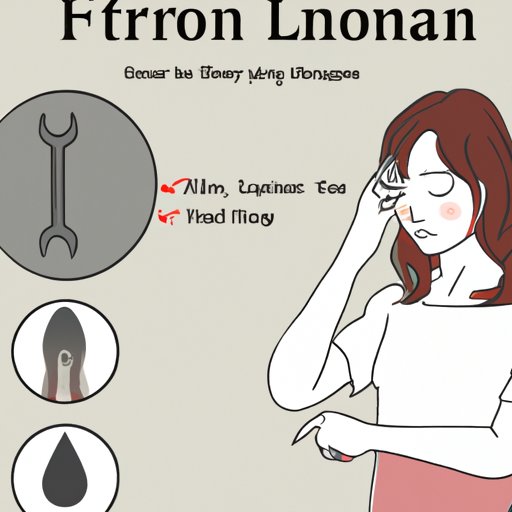I. Introduction
Iron is an essential mineral that plays a critical role in the production of red blood cells, and when our body doesn’t have enough iron, it can lead to a condition called low iron (iron deficiency). While it often goes unnoticed, it can cause serious health issues if left untreated. This article will help you understand the symptoms of low iron and how to treat it.
II. Iron Deficiency: A Hidden Epidemic and Its Telltale Signs
Iron deficiency is a common problem, with an estimated two billion people worldwide suffering from it. The cause of this condition is due to several factors such as excessive blood loss, pregnancy and breastfeeding, or not consuming enough iron-rich foods. Iron deficiency can also be a genetic issue, meaning it can be congenital or inherited.
The common symptoms of iron deficiency are often subtle and can be tough to spot, making it a hidden epidemic. Some of the telltale signs include fatigue, weakness, shortness of breath, headaches, dizziness, and pale skin among others.
III. The Top 5 Symptoms of Low Iron and How to Treat Them
Here are the top five symptoms of low iron:
Fatigue
One of the most common symptoms of low iron is fatigue or extreme tiredness. This can happen because iron is a crucial component in producing hemoglobin, the oxygen-carrying protein in red blood cells. Without iron, our bodies struggle to transport enough oxygen to the tissues and muscles, resulting in fatigue.
Weakness
Iron is essential for proper muscle function. Low iron levels may lead to muscle weakness, low endurance, and diminished athletic performance. Muscle fatigue and general weakness paves the way for accidents and injuries to occur, so getting proper treatment for low iron levels is vital for minimizing these risks.
Shortness of breath and rapid heartbeat
Iron is responsible for the production of hemoglobin, the protein that carries oxygen in your blood, and without iron, the body can’t produce enough hemoglobin to transport oxygen throughout our body. This results in feelings of shortness of breath, rapid or irregular heartbeat at rest, chest pain, and tachycardia (fast heart beat).
Headaches and dizziness
Low iron can cause headaches that may range from mild to severe, and they can strike regularly. Dizziness and lightheadedness are also common symptoms of low iron.
Pale skin and fingernails
Iron is necessary to ensure your skin and nails get the proper oxygen and nutrients needed to sustain healthy growth. Low iron levels can make your skin and nails appear ghostly pale or yellowish, indicating low oxygen levels in the blood.
Some of the treatment options for low iron include taking iron supplements or an iron-rich diet. For medically diagnosed individuals, they may need a transfusion of red blood cells injected with iron to get the necessary levels of iron in their system.
IV. Signs That You Have Low Iron Levels And What You Can Do About It
It’s essential to get tested for low iron levels regularly, particularly if you have risk factors or some of the symptoms mentioned above. The recommended testing methods are a complete blood count (CBC) or serum ferritin test, which measures the amount of iron stored in the body.
The medical provider typically treats iron deficiency depending on underlying causes. Low iron levels resulting from anemia or menstrual bleeding can be treated with iron supplements or blood transfusions. In contrast, low iron caused by other medical conditions may require changes in diet, environmental modifications, or possibly surgery.
V. Are You Suffering from Low Iron? Recognizing the Symptoms and Finding Solutions
It can be challenging to diagnose low iron since the symptoms can be subtle and generic. Suppose you suspect iron deficiency. In that case, you should seek medical advice and get tested to confirm the diagnosis. The medical professional will instruct you on how to optimize your iron levels, either via lifestyle changes or various supplements.
Some natural ways to boost iron levels include increasing your iron-rich food consumption, which includes red meat, poultry, seafood, spinach, kale, beans, and lentils. If you’re considering taking a dietary supplement, it’s necessary to talk to your healthcare professional, as some supplements, particularly iron, can interfere with other medications.
VI. What Your Body Might Be Saying: 5 Common Symptoms of Low Iron You Shouldn’t Ignore
There are many other signs and symptoms of low iron. Here are five potential indications that you might be iron deficient:
Brittle hair and hair loss
A lack of iron in your diet can impact hair growth, leading to brittle hair and hair loss. This particular symptom is most common in women experiencing iron deficiency due to menstruation or pregnancy.
Restless leg syndrome
Restless leg syndrome is a neurological condition, and low iron levels have been known to cause it. This syndrome makes you feel like moving your legs all the time, interfering with your sleep and adversely affecting your quality of life.
Cravings for non-food items
This symptom occurs mainly in pregnant women and young children with iron deficiency. Pica, or the craving for non-food items, such as dirt or chalk, is a clear sign that iron levels may be too low.
Cold hands and feet
Iron plays an essential role in helping your body produce red blood cells, transport oxygen from your lungs throughout the body, and keep energy levels up. With low iron levels, your body will struggle to maintain the proper oxygen levels in the body, resulting in cold hands and feet.
Frequent infections
Iron plays a crucial role in the immune system, helping the body fight off harmful bacteria and pathogens. When iron levels are too low, the immune system is compromised, leading to more frequent infections and generally feeling unwell.
VII. Conclusion
The symptoms of low iron can be challenging to recognize since they are often subtle and can be confused with other conditions. However, if you’re experiencing any symptoms mentioned in this article, it’s essential to get in touch with a healthcare professional to assess your iron status.
